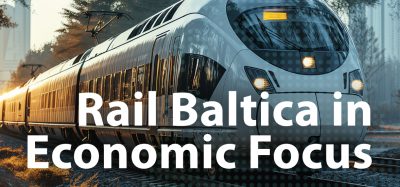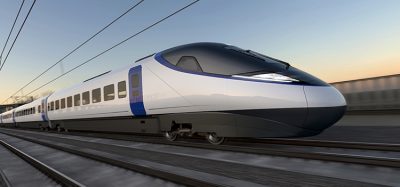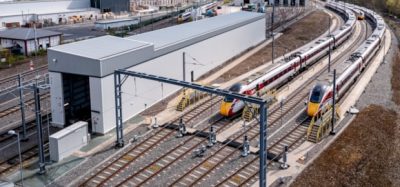NSB’s success story
Posted: 26 November 2007 | | No comments yet
NSB enters the fourth quarter of 2007 with historical results. The Norwegian media is reporting an approximate revenue increase of 10% for the first half of 2007 and an equivalent increase in passenger traffic. If this trend continues, the total number of passengers for this year is estimated to reach 53 million.
NSB enters the fourth quarter of 2007 with historical results. The Norwegian media is reporting an approximate revenue increase of 10% for the first half of 2007 and an equivalent increase in passenger traffic. If this trend continues, the total number of passengers for this year is estimated to reach 53 million.
NSB enters the fourth quarter of 2007 with historical results. The Norwegian media is reporting an approximate revenue increase of 10% for the first half of 2007 and an equivalent increase in passenger traffic. If this trend continues, the total number of passengers for this year is estimated to reach 53 million.
What is the reason behind this? Are the road conditions in Norway, in particular those connecting the major cities and around the capital, Oslo, a cause of this? Does ever increasing environmental awareness affect our passenger numbers or is the increase a result of improved offerings by our behalf? In any case, because of this development, NSB has no choice but to expand and further improve its business. The traffic capacity around Oslo’s central station is already exceeding 100% usage, especially in their daily rush hour times.
The only way to accommodate for this passenger increase is first and foremost to buy new trains and modernise and refurbish our existing rolling stock. NSB is therefore in the process of investing approximately 5 billion Norwegian kroner in the next few years. Secondly, we need to introduce technological improvements in order to facilitate for better, safer and more efficient use of this new material and the existing infrastructure.
What challenges do we face?
Purchasing of new trains
NSB is in the process of purchasing 50 new train sets with an option for 100. The procurement process hinders me discussing in more detail about this train set and will have to be left for a future presentation.
Refurbishment of Type 7 coaches
Type 7 is our newest passenger coach built between 1980 and 1989. Coaches are made of aluminium, with a wide profile, suited for Norwegian comfort standards and possibilities for ‘tilting’ operations. The coaches are in use in long distance trains connecting Oslo to Bergen, Trondheim and Stavanger. These were modernised earlier, but are no longer thought to meet the marketing and esthetical demands for this type of train product.
EuroMaint, a Swedish company located in Malmø, has been commissioned to carry out the refurbishment of the Type 7 coaches.
The goals we are looking at to reach modernisation standards are:
- Better customer comfort
- Raising the aesthetics with the possibility of incorporating completely new designs
- Maintain and exceed safety standards
- Improving reliability and accessibility
- Reducing maintenance costs
- Improving the staff working environment
To reach these goals, the project will include:
- Repainting the exterior and interior
- Enlarging the luggage areas
- Installing new chairs
- Installing mains sockets for all seats
- Modernising the toilets
- Installing air-conditioning
- Installing new electrical doors with new functions
- Installing new recycling stations
- Improving the speaker functionality
- Installing new electronic information displays
- Preparing for WLAN
- Integrating repeaters for mobile phones
- Installation of smoke detectors in all toilets, electrical lockers and storage rooms
- Installing manual fire alarms in all coaches
Type 7 coaches have been adapted for various uses during the years in service. Out of these, three types will receive major upgrades. One of these is the NSB Family coaches which will receive improvements such as:
- Installation of wire loops for passengers with impaired hearing
- Implementation of dedicated seating areas for wheel-chair users integrated in the seating compartments
- Creating new child playrooms plus incorporating mother/child compartments next to the playrooms
- Ensuring there is sufficient storage space for baby carriages
The NSB Comfort coaches offer our passengers premium comfort. These coaches will also benefit from an upgrade which will include:
- New fixed chairs with wider arm rests
- Fixed tables with two or four extension flaps
- A new standing table section with warm drink vendors and newspapers
NSB Bistro coaches will receive new kitchens with various kitchen interior improvements plus new self-service areas.
Refurbishment of Type 5 coaches
Both our customers and staff have been satisfied with our Type 5 coaches for more than 20 years now. The coaches, acquired between 1977 and 1981, have unfortunately lost their comfort during their many years in service and must be modernised to current standards.
56 coaches of Type 5 will be completely refurbished so as to renew their appearance and prolong their service life for up to 20 years. The upgrades include:
- Fire suppressing measures
- New interiors
- Closed circuit toilets
- New chairs
- Exterior repainting
- Installation of air-conditioning
- New electrical system
- New doors
- New bogies
After these improvements have been completed, the only thing remaining from the original coaches will be the steel framework. The modifications will be completed by Bombardier Transportation.
Refurbishment of 69C coaches
14 train sets in the series 69C will share the same fate as most of the current, older NSB rolling stock. Complete interior and exterior upgrades with the purpose of raising the standard for both our passengers and on-board staff.
For this purpose, new lighting will be installed along with air-conditioning, new closed circuit toilets, a new information system, fire detection systems, new doors and new seats.
NSB gives special regard to improving accessibility for wheel-chair users, something these coaches were not originally designed for and this will require extensive work. Upgrades will include wheel-chair lifts on both sides of the coach, anchoring as well as safety belts and alarm buttons for summoning an attendant. These will also be installed in the new toilets.
In addition to interior features there will be technical improvements such as a complete new fire detection system, preparations for a video surveillance system, new automatical train control system as well as a new registration unit with a digital speed indicator. Driver cabins will be totally refurbished in order to improve the drivers working environment.
Next in line after this upgrade is the newest commuter Type 69 train series D and older NSB rolling stock (Type 70, Di4). Eventually, all will share a similar upgrade make-over.
Technological improvements
Implementation of GSM-R in NSB’s rolling stock
Thanks to the strategical choice of development of GSM-R in Norway, where the migration from analogue radio to the GSM-R radio was based on doubling of infrastructure, NSB has not had any major problems with the transition from the analogue SCANET radio to GSM-R radio. The infrastructure owner (Jernbaneverket or JBV) has chosen to keep the existing analogue network working parallel with the development of the new digital GSM-R network.
The infrastructure part of GSM-R in Norway was truly a challenge due to its special geographical and climatical conditions. Approximately 600 tunnels have been worked on to ensure continuous radio coverage on a total of 3,900km of railway. 650 base stations had to be built, including transmission. The GSM-R network is interconnected with seven train-leader operator centres and the entire network is controlled and operated from the new operational centre in Marienborg, Trondheim.
We can safely say today that the status existing infrastructure is in the finishing stages, with only some minor adjustments to software to be made.
NSB’s first step towards implementing GSM-R was the instalment of OPH 940 Sagem 2W GSM-R radio. The installation included an external antenna, a car-kit and a microphone. We have been permitted by Norwegian Railway Inspectorate (Statens Jernbanetilsynet) to use this solution until the end of 2008. Both the telephone and the holder will be replaced due to poor technical performance, so in stead of OPH 940 we will be using the TigR155 by the same manufacturer.
The 8W cab radio we chose during the tender process is from Herman FUNKWERK. The model chosen (MESA 25-2) is almost identical to the solution chosen by the Swiss SBB CFF FFS (MESA 25-1).
NSB has been running its diesel material in the north of Norway (Di2, Di3, Di4, Type 92, Type 93 and Y1) with installed GSM-R cab radio. The northern part of Norway was not covered with the analogue network but was relying on NMT-450 MHz so the authorities (Statens Jernbanetilsynet or SJT) decided to introduce GSM-R here first.
The main milestone in the implementation of GSM-R in Norway is planned for August of 2008, when the analogue network is to be switched off permanently and a total migration to use GSM-R on all NSB rolling stock is to be implemented.
ERTMS in Sweden and Norway
The development of ERTMS is based on a tight cooperation between Sweden and Norway (JB and JBV) due to a historical fact that the ATC system in use today, the JZG 700, is implemented in both these countries. Sweden and Norway have achieved inter-compatibility with the current system and it is therefore only fitting that this continues as ERTMS is implemented.
There are three separate programs that JB and JBV will have to run in order to implement ERTMS:
- STM (Specific Transmission Module)
- EOS (ERTMS onboard equipment)
- ERTMS REGIONAL
STM was chosen for migration from the existing ATC system to ERTMS. It will allow us to run ERTMS onboard equipment on all our rolling stock even before the entire ERTMS infrastructure is in place. The development of STM is given to AnsaldoSTS and some of the most important criteria is that the system will be nationally standardised and stand alone (separated from the ERTMS onboard equipment). We expect STM to be fully implemented by 2009.
The EOS project is mandated to choose at least two suppliers for the ERTMS onboard system. The framework agreement will be based on ordering the necessary products and service for set pricing and conditions. The tender process is ongoing and the deadline for implementation is set at 2009, corresponding to the implementation of STM.
JBV has chosen in its signalling strategic plan to implement ERTMS Level 2 Regional. The ERTMS implementation will be based on a pilot programme due to run at full capacity in 2012. Due to the poor technical condition of most of the current signalling equipment in Norway, there is a strong wish to finish work on ERTMS as fast as financing allows. This is why JBV has adopted an ambitious 15 year plan, setting the full implementation of ERTMS to end in 2030.
Internet in trains
As one of the concepts for increasing the standard in our trains, a pilot project has already been run for testing the necessary technology for on-board internet. The most adequate solution for NSB is an aggregate system that enables us to connect to already existent infrastructure and utilise the one with best accessibility at the train’s current location. This project is in development.
CCTV in commuter trains
As a means of increasing passenger safety, especially at night time and better vandalism protection of our material, work on the implementation of closed circuit television surveillance in our commuter trains is expected to commence next year. Along with many others, this project is still in a tender phase, but once fully implemented, it will hopefully decrease the downtime of our rolling stock in need of maintenance due to vandalism and therefore increase punctuality.
This can be taken as a short overview of the activities in NSB which will be carried out in order to increase our capacity and product quality. I am unable to mention all of the projects currently in development aimed at reaching this goal, but their achievement will soon be felt by our passengers when all these projects are put to use.
Issue
Related topics
European Rail Traffic Management System (ERTMS), Global System for Mobile Communications – Railway (GSM-R), Rolling Stock Orders/Developments







